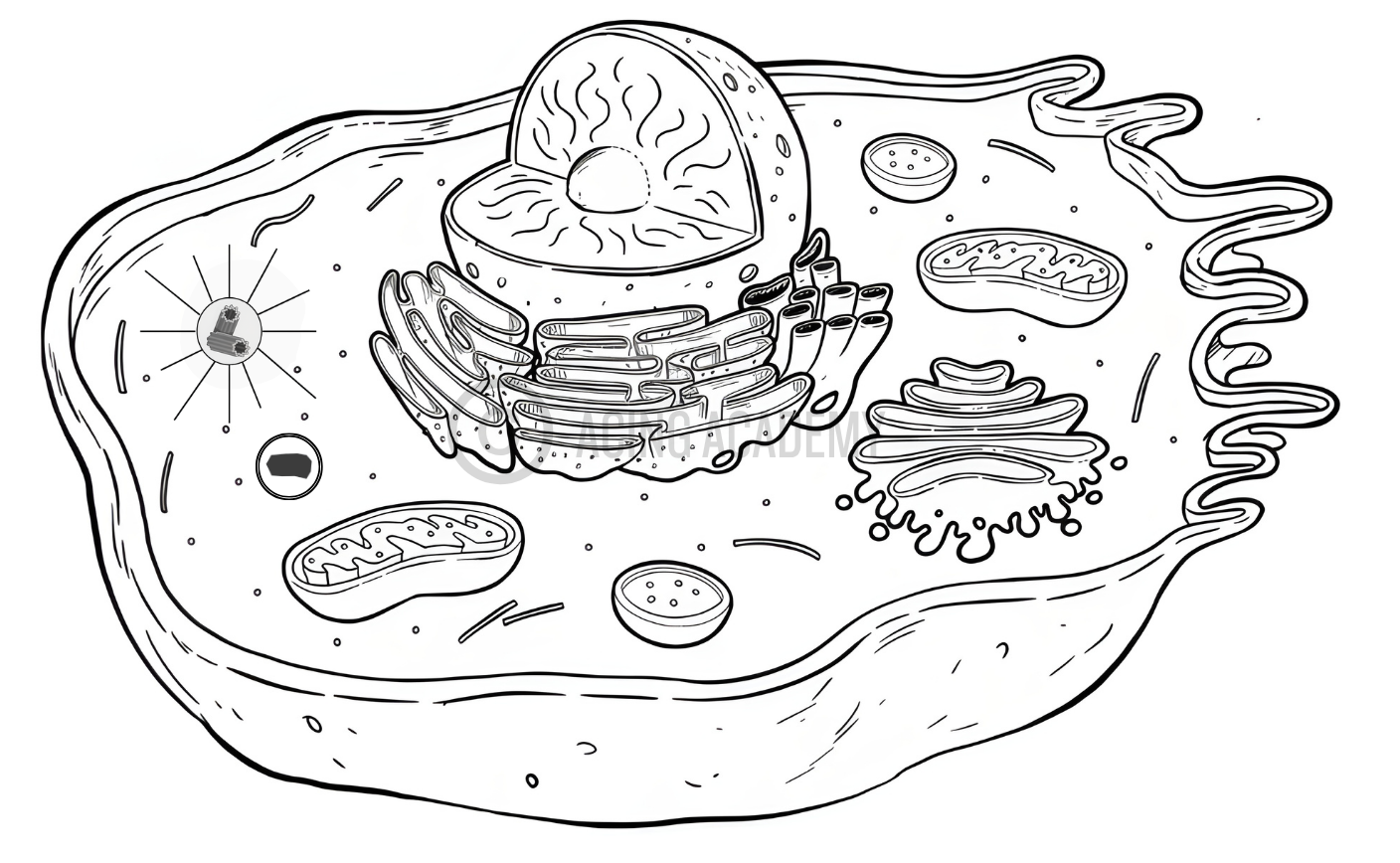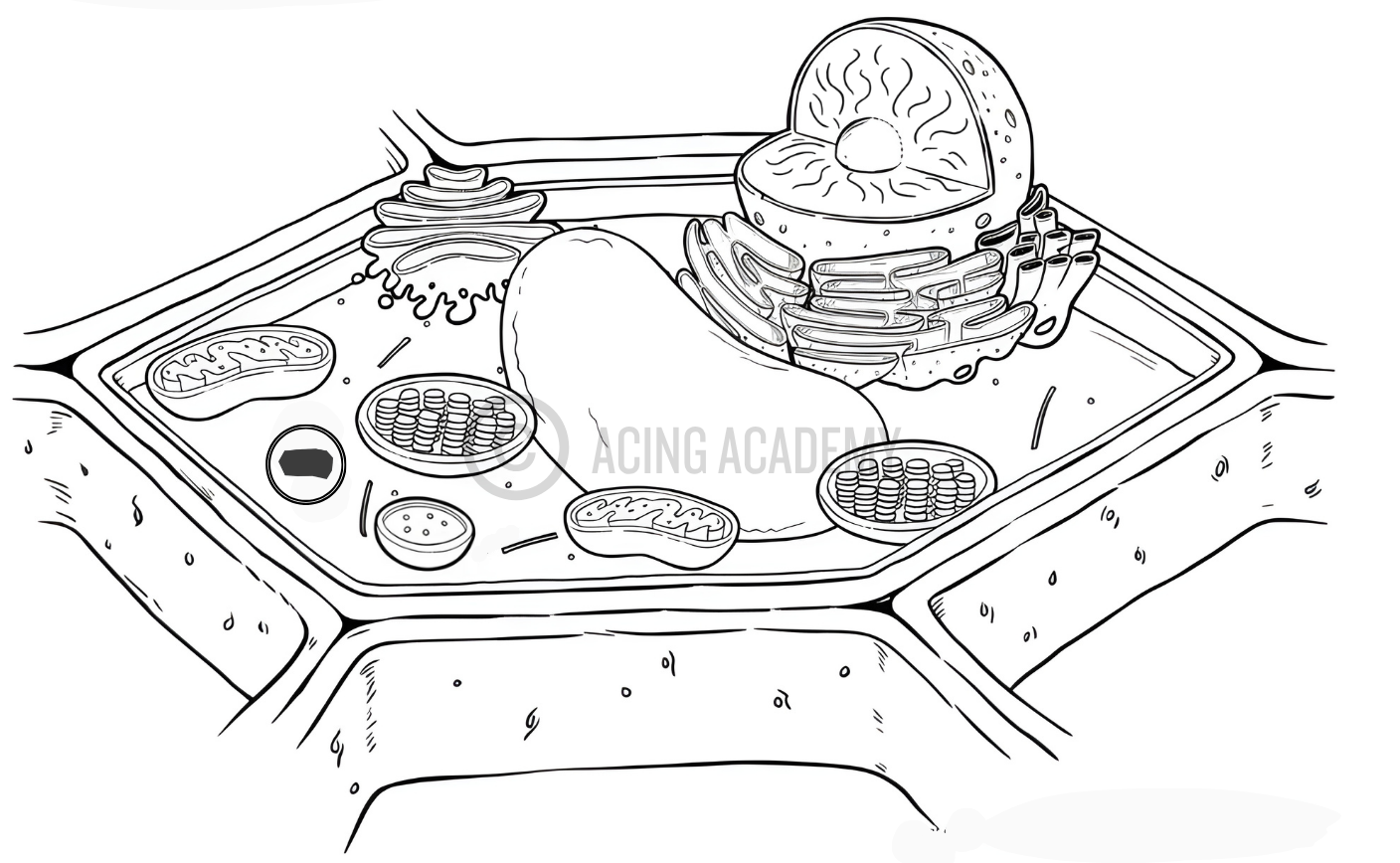Cell , Cell Theory and Cell Organelles
unicellular
multicellular
Mycoplasma
lowest
deoxyribonucleic acid (DNA)
compound microscope
1665
to view cells under a microscope
Single Celled
Diversity
1838
Plant
Tissues
Animal
Plasma Membrane
pre-existing cells
cell division.
an egg cell of ostrich
Cells are the fundamental units of life, serving as the building blocks of all living organisms. Developed through the groundbreaking contributions of scientists like Matthias Schleiden, Theodore Schwann, and Rudolf Virchow, cell theory established that all living beings are composed of cells and their products. These cells exhibit remarkable diversity, with each organelle contributing to their specific functions and the overall vitality of living organisms.
All organisms are made up of cells. They may be made up of a Single Cell , or Many Cells (multicellular). Smallest known cells are called While the Largest Cells ever discovered are . Cells are the building blocks of all living beings. They provide structure to the body and convert the nutrients taken from the food into energy.
Cells are complex and their components perform various functions in an organism. They are of different shapes and sizes, pretty much like bricks of the buildings. Our body is made up of cells of different shapes and sizes.
Cells are the Level of organisation in every life form. From organism to organism, the count of cells may vary. Humans have more number of cells compared to that of bacteria.
Cells comprise several cell organelles that perform specialised functions to carry out life processes. Every organelle has a specific structure. The Hereditary material of the organisms is also present in the cells.
1. Cell Theory
The Discovery of cells has a rich history, including the development of microscopes, the contributions of scientists, and the evolution of cell theory. Let us see Various Contributors to the Cells and Cell Theory through Timeline Infographic
Cell Theory: The cell theory was developed in the mid-1800s and states that all living things are composed of cells, the fundamental structural and organizational units of all organisms. Additionally, it shows that all cells arise from preexisting cells. Cells are essential as all living organisms’ basic structural and reproductive units.
While this theory was once widely accepted, some biologists now challenge its first principle by considering non-cellular entities like viruses as living organisms. This disagreement arises from the lack of a universally accepted definition of life, resulting in ongoing scientific discussions.
The classical Cell Theory comprises three fundamental principles:
1. Cells are the basic unit of life.
2. All living things are composed of cells.
3. Cells originate from pre-existing cells.
2. Cell Organalles and their Funtions
Animal Cell

Plant Cell

Nucleolus
Introduction
Cell membrane is also known as the plasma membrane. The plasma membrane is porous and allows certain substances or materials move both inward and outward. Viruses lack any membranes and hence do not show characteristics of life.
Endocytosis
The plasma membrane is flexible and is made up of organic molecules called lipids and proteins.
The flexibility of the cell membrane also enables the cell to engulf in food and other material from its external environment. Such processes are known as endocytosis (endo → internal; cyto → of a cell). Amoeba acquires its food through such processes.
Diffusion
Plasma membrane is a selectively permeable membrane [The plasma membrane is porous and allows the movement of substances or materials both inward and outward].
Some substances like carbon dioxide or oxygen can move across the cell membrane by a process called diffusion [spontaneous movement of a substance from a region of high concentration (hypertonic solution) to a region where its concentration is low (hypotonic solution)].
Thus, diffusion plays an important role in gaseous exchange between the cells as well as the cell and its external environment.
Osmosis
Water also obeys the law of diffusion. The movement of water molecules through a selectively permeable membrane is called osmosis.
Osmosis is the passage of water from a region of high water concentration through a semi-permeable membrane to a region of low water concentration. Thus, osmosis is a special case of diffusion through a selectively permeable membrane.
Unicellular freshwater organisms and most plant cells tend to gain water through osmosis. Absorption of water by plant roots is also an example of osmosis.
Thus, diffusion is important in exchange of gases and water in the life of a cell. In additions to this, the cell also obtains nutrition from its environment.
Different molecules move in and out of the cell through a type of transport requiring use of energy in the form of ATP.
Reverse Osmosis
Reverse osmosis (RO) is a water purification technology that uses a semipermeable membrane to remove larger particles from drinking water.
In reverse osmosis, an applied pressure is used to overcome osmotic pressure.
Reverse Osmosis is a phenomenon where pure water flows from a dilute solution [hypotonic] through a semi permeable membrane to a higher concentrated solution [hypertonic].
Semi permeable means that the membrane will allow small molecules and ions to pass through it but acts as a barrier to larger molecules or dissolved substances.
Introduction
Cell wall is absent in animals.
Plant cells, in addition to the plasma membrane, have another rigid outer covering called the cell wall. The cell wall lies outside the plasma membrane.
The plant cell wall is mainly composed of cellulose. Cellulose is a complex substance and provides structural strength to plants.
Plasmolysis
When a living plant cell loses water through osmosis there is shrinkage or contraction of the contents of the cell away from the cell wall. This phenomenon is known as plasmolysis (plasma → fluid; lysis → disintegration, decomposition).
Only living cells, and not dead cells, are able to absorb water by osmosis. Cell walls permit the cells of plants, fungi and bacteria to withstand very dilute [hypotonic] external media without shrinkage.
In such media the cells tend to lose water by osmosis. The cell shrinks, building up pressure against the cell wall. The wall exerts an equal pressure against the shrunken cell.
Cell wall also prevents the bursting of cells when the cells are surrounded by a hypertonic medium (medium of high concentration).
In such media the cells tend to gain water by osmosis. The cell swells, building up pressure against the cell wall. The wall exerts an equal pressure against the swollen cell.
Because of their walls, plant cells can withstand much greater changes in the surrounding medium than animal cells.
It is the jelly-like substance present between the cell membrane and the nucleus. The cytoplasm is the fluid content inside the plasma membrane. It also contains many specialized cell organelles [mitochondria, golgi bodies, ribosomes, etc].
Introduction
It is generally spherical and located in the center of the cell. It can be stained and seen easily with the help of a microscope. Nucleus, in addition to its role in inheritance, acts as control center of the activities of the cell.
The entire content of a living cell is known as protoplasm [cytoplasm + nucleus]. It includes the cytoplasm and the nucleus. Protoplasm is called the living substance of the cell.
Nuclear Membrane
Nucleus is separated from the cytoplasm by a double layered membrane called the nuclear membrane. This membrane is also porous and allows the movement of materials between the cytoplasm and the inside of the nucleus [diffusion].
The nucleus of the bacterial cell is not well organized like the cells of multicellular organisms. There is no nuclear membrane.
Chromosomes
In addition, nucleus contains thread-like structures called chromosomes. Chromosomes are structures only found in the nucleus of cells (also found in Mitocondria) that are made of DNA tightly packed with proteins, and a gene is a specific segment of that DNA. Genes and help in inheritance or transfer of characters from the parents to the offspring. The chromosomes can be seen only when the cell divides.
Although chromosomes are made primarily of DNA and proteins. The RNA is found in small amounts as various non-coding RNAs that play role in decoding the information of DNA for protein synthesis.
Introduction
Mitochondria are known as the powerhouse of the cell.
The energy required for various chemical activities needed for life is released by mitochondria in the form of ATP (Adenosine Triphosphate) molecules.
Mitochondria have two membrane coverings instead of just one.
The outer membrane is very porous while the inner membrane is deeply folded. These folds create a large surface area for ATP-generating chemical reactions.
Mitochondria are strange organelles in the sense that they have their own DNA and ribosomes. Therefore, mitochondria are able to make some of their own proteins [ribosomes prepare proteins].
ATP
ATP is known as the energy currency of the cell. The body uses energy stored in ATP for making new chemical compounds and for mechanical work. [If Mitochondria is the Power Plant. ATP is the Electricity].
The golgi apparatus consists of a system of membrane-bound vesicles arranged approximately parallel to each other in stacks called cisterns.
These membranes often have connections with the membranes of ER and therefore constitute another portion of a complex cellular membrane system.
The material synthesized near the ER is packaged and dispatched to various targets inside and outside the cell through the golgi apparatus.
Its functions include the storage, modification and packaging of products in vesicles.
In some cases, complex sugars may be made from simple sugars in the golgi apparatus.
The golgi apparatus is also involved in the formation of lysosomes.
Lysosomes are a kind of waste disposal system of the cell.
Lysosomes help to keep the cell clean by digesting any foreign material as well as worn-out cell organelles.
Foreign materials entering the cell, such as bacteria or food, as well as old organelles end up in the lysosomes, which break them up into small pieces. Lysosomes are able to do this because they contain powerful digestive enzymes capable of breaking down all organic material.
During the disturbance in cellular metabolism, for example, when the cell gets damaged, lysosomes may burst and the enzymes digest their own cell. Therefore, lysosomes are also known as the ‘suicide bags’ of a cell.
Structurally, lysosomes are membrane-bound sacs filled with digestive enzymes. These enzymes are made by RER.
Introduction
The endoplasmic reticulum (ER) is a large network of membrane-bound tubes and sheets. It looks like long tubules or round or long bags (vesicles).
The ER membrane is similar in structure to the plasma membrane.
There are two types of ER –– rough endoplasmic reticulum (RER) and smooth endoplasmic reticulum (SER).
Some of these proteins and lipids help in building the cell membrane. This process is known as membrane biogenesis.
Some other proteins and lipids function as enzymes and hormones.
Although the ER varies greatly in appearance in different cells, it always forms a network system.
Thus, one function of the ER is to serve as channels for the transport of materials (especially proteins) between various regions of the cytoplasm or between the cytoplasm and the nucleus.
The ER also functions as a cytoplasmic framework providing a surface for some of the biochemical activities of the cell.
In the liver cells of the group of animals called vertebrates, SER plays a crucial role in detoxifying many poisons and drugs.
Rough Endoplasmic Reticulum (RER)
RER looks rough under a microscope because it has particles called ribosomes attached to its surface.
The ribosomes, which are present in all active cells, are the sites of protein manufacture.
The manufactured proteins are then sent to various places in the cell depending on need, using the ER.
Smooth Endoplasmic Reticulum (SER)
The SER helps in the manufacture of fat molecules, or lipids, important for cell function.
You might have noticed several small colored bodies in the cytoplasm of the cells of Tradescantia leaf. They are scattered in the cytoplasm of the leaf cells. These are called plastids.
They are of different colours. Some of them contain green pigment called chlorophyll. Green coloured plastids are called chloroplasts. They provide green colour to the leaves.
Chloroplasts are important for photosynthesis in plants.
Chloroplasts also contain various yellow or orange pigments in addition to chlorophyll.
Plastids are present only in plant cells. There are two types of plastids – chromoplasts (coloured plastids) and leucoplasts (white or colourless plastids).
Leucoplasts are primarily organelles in which materials such as starch, oils and protein granules are stored.
The internal organization of the plastids consists of numerous membrane layers embedded in a material called the stroma.
Plastids are similar to mitochondria in external structure. Like the mitochondria, plastids also have their own dna and ribosomes.
3. Plant vs Animal Cell – a Comparative Analysis
| Comparision Basis | Animal Cell | Plant Cell |
|---|---|---|
| Nucleus | Present | Present |
| Cilia | Present | It is very rare |
| Shape | Round (irregular shape) | Rectangular (fixed shape) |
| Chloroplast | Animal cells don’t have chloroplasts | Plant cells have chloroplasts because they make their own food |
| Cytoplasm | Present | Present |
| Endoplasmic Reticulum (Smooth and Rough) | Present | Present |
| Ribosomes | Present | Present |
| Mitochondria | Present | Present |
| Vacuole | One or more small vacuoles (much smaller than plant cells). | One. large central vacuole taking up 90% of cell volume. |


 UPSC Exams
UPSC Exams  UPSC CSE
UPSC CSE UPSC CAPF
UPSC CAPF UPSC CDS
UPSC CDS UPSC NDA
UPSC NDA UPSC EPFO
UPSC EPFO UPSC CISF LDCE
UPSC CISF LDCE State Upper PCS
State Upper PCS  UPPSC PCS
UPPSC PCS BPSC CCE
BPSC CCE RPSC RAS
RPSC RAS MPPSC (Madhya Pradesh) CCE
MPPSC (Madhya Pradesh) CCE MPSC (Maharasthra) Rajyaseva
MPSC (Maharasthra) Rajyaseva WBPSC WBCS
WBPSC WBCS GPSC CCE
GPSC CCE KPSC (Karnataka) KAS
KPSC (Karnataka) KAS APSC (Assam) CCE
APSC (Assam) CCE View More
View More Defence
Defence AFCAT
AFCAT BSF SI
BSF SI Indian Army Agniveer
Indian Army Agniveer Banking
Banking  IBPS PO
IBPS PO SBI PO
SBI PO RBI Grade B
RBI Grade B Cental Bank Of India Apprentice
Cental Bank Of India Apprentice IDBI Junior Assistant Manager
IDBI Junior Assistant Manager SSC
SSC  Police
Police  Bihar Police SI
Bihar Police SI UP Police SI
UP Police SI Delhi Police Head Constable
Delhi Police Head Constable Rajasthan Police SI
Rajasthan Police SI WB Police SI
WB Police SI Assam Police SI
Assam Police SI Odisha Police SI
Odisha Police SI Railway
Railway Other State Exams
Other State Exams Insurance
Insurance Regulatory Body
Regulatory Body